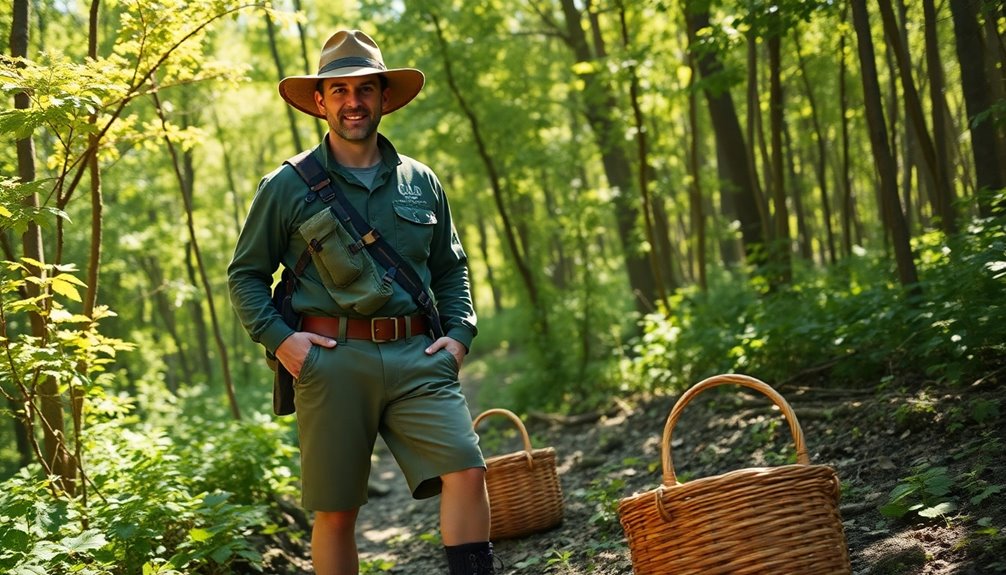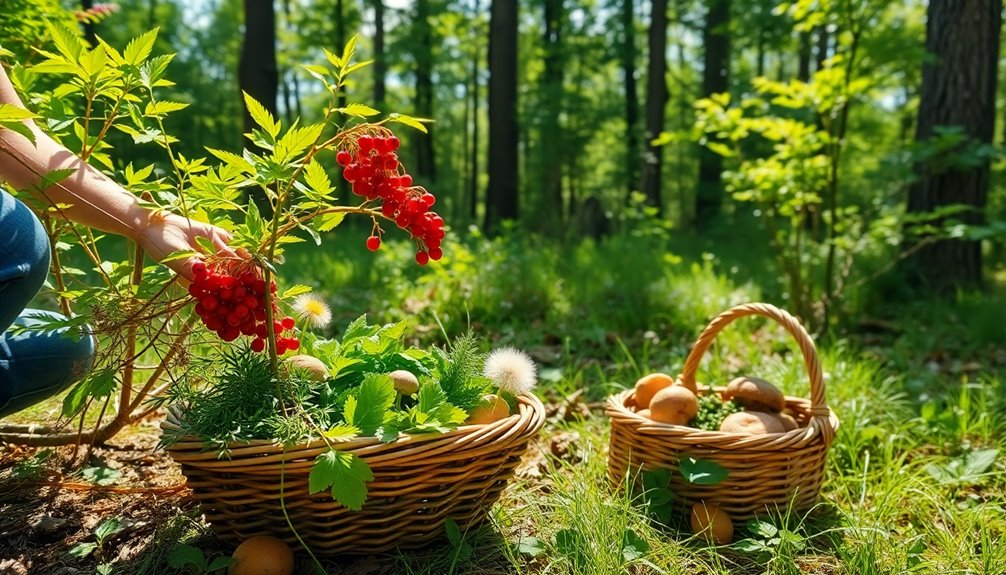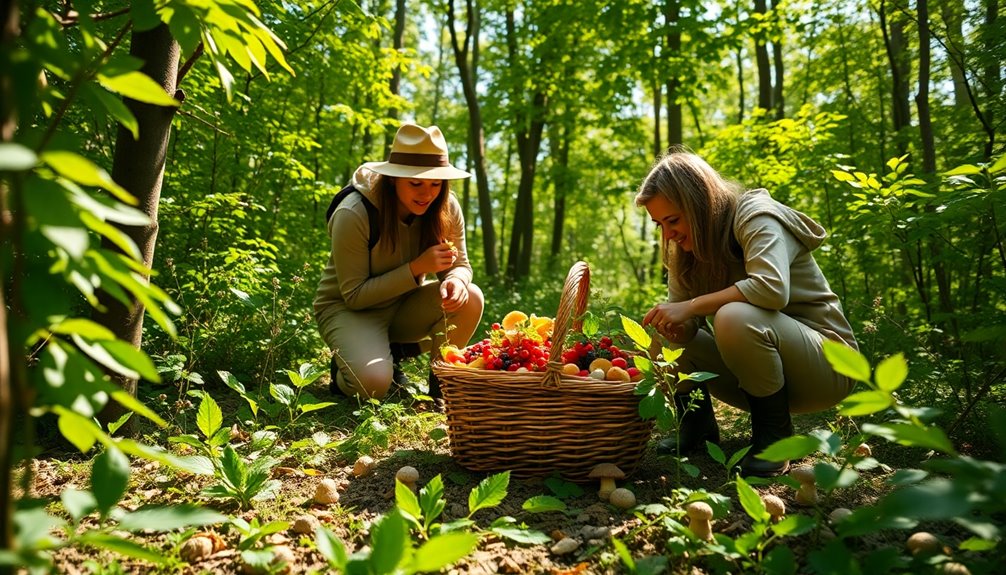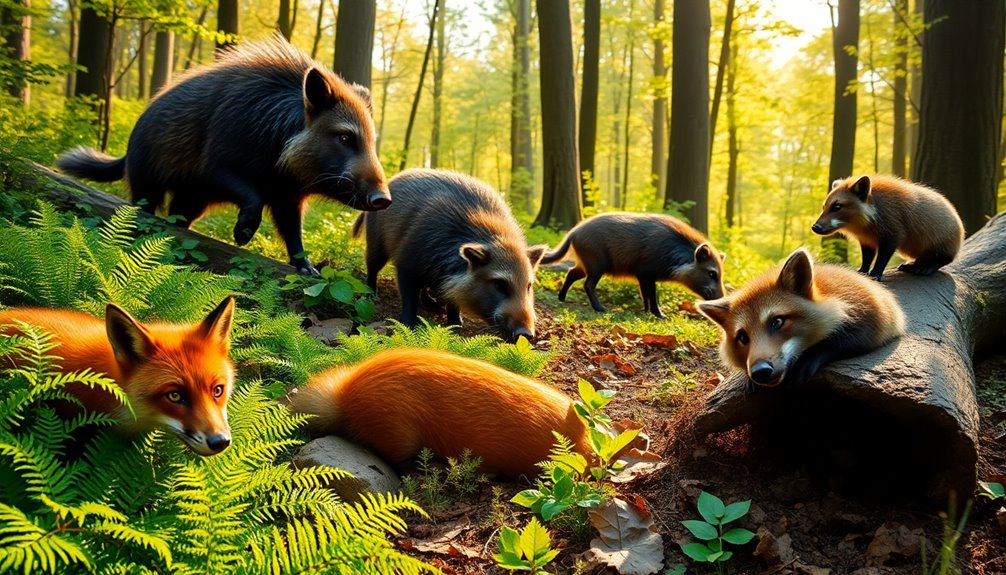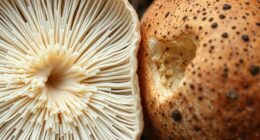When you go foraging, wear long pants and long-sleeved shirts to protect yourself from ticks and mosquitoes. Rubber boots will keep your ankles safe and offer stability on muddy ground. Don't forget a hat to shield your face from UV rays and insects. Bright colors are smart during hunting season to enhance visibility. Consider using deer ked nets or jackets for extra insect protection. Staying comfortable and safe in the wild is key. By choosing the right outfit, you'll boost your foraging experience and confidence. Keep going, and you'll uncover more essential tips for a successful outing!
Key Takeaways
- Wear long pants and long-sleeved shirts to protect against ticks, mosquitoes, and UV rays while foraging.
- Choose rubber boots for ankle support and stability on wet or uneven terrain during your foraging adventures.
- Opt for bright-colored clothing to enhance visibility, especially in areas where hunting may take place.
- Use hats or caps to shield your face and neck from sun exposure and pesky insects.
- Consider wearing deer ked nets or jackets to minimize insect bites for a more comfortable experience.
Essential Clothing for Foraging
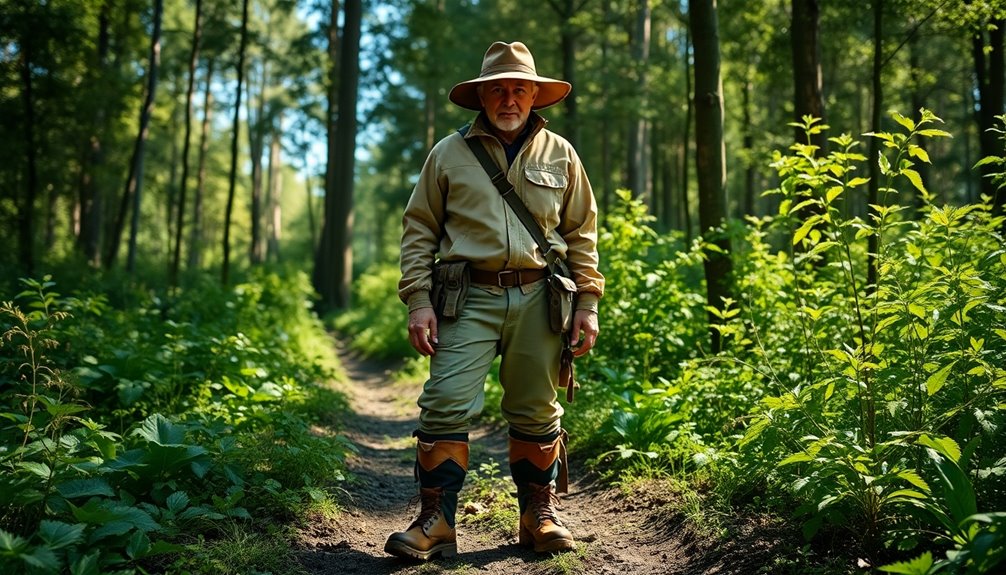
When you're heading out foraging, choosing the right clothing is essential for both comfort and safety. Start with long pants and long-sleeved shirts to protect your legs and arms from ticks, mosquitoes, and other potential hazards. These garments greatly reduce the risk of diseases like Lyme disease and encephalitis, keeping you safer in the wild.
Rubber boots are a must, especially if you're foraging in wet areas. They protect your ankles from bites and provide stability on slippery surfaces, allowing you to focus on your foraging without worrying about your footing.
A hat or cap is also a smart addition; it shields your face and neck from harmful UV rays while keeping pesky insects away.
Consider wearing brightly colored clothing to enhance visibility in the wilderness, particularly during hunting season. This helps you stay safe and easily navigate your surroundings.
Finally, think about using a deer ked net or jacket to combat deer ked and mosquitoes. Even if you don't wear it initially, having it on hand can make your foraging experience much more enjoyable.
Dress wisely, and you'll be well-prepared for your foraging adventures!
Tools for Berry Picking
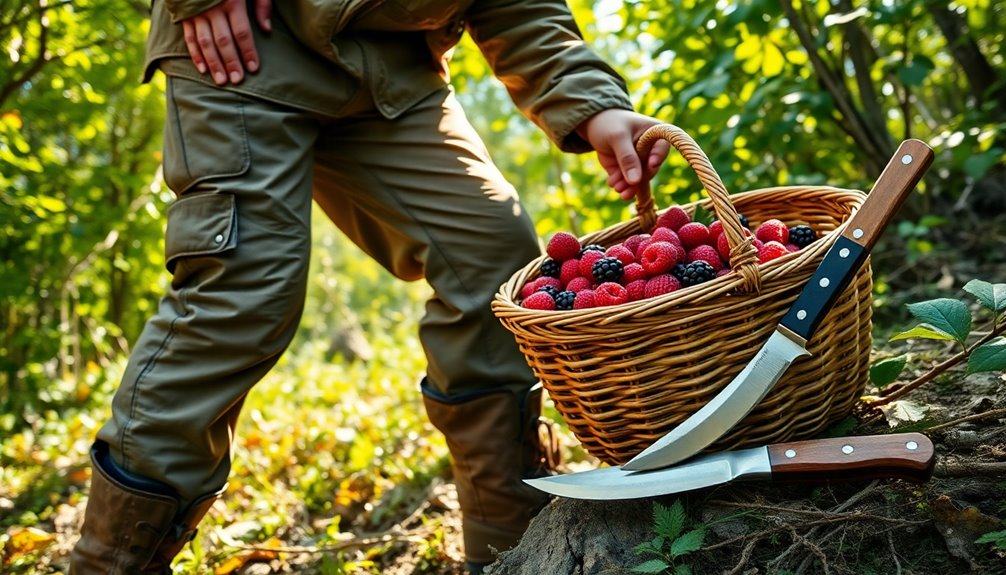
Whether you're a seasoned forager or just starting out, having the right tools for berry picking can make all the difference. A berry picker is essential for harvesting firm berries like bilberries, speeding up your collection while minimizing damage to the fruit.
Pair this with a 10-liter bucket for blueberries and lingonberries; it's spacious enough to hold plenty while still being easy to carry.
To keep your hands free while maneuvering through the bushes, consider a fanny pack. This lets you carry essential tools and snacks without hindering your movements.
Don't forget to pack a water bottle to stay hydrated, especially on long foraging trips.
Having a printed map can also be a lifesaver, helping you track your location and avoid getting lost in unfamiliar areas.
Plus, make sure your mobile phone is fully charged and equipped with emergency apps, like 112 Suomi. This precaution gives you peace of mind during your berry picking adventures.
With the right tools, you'll enhance your foraging experience and make the most of your time in the wild!
Tools for Mushroom Picking
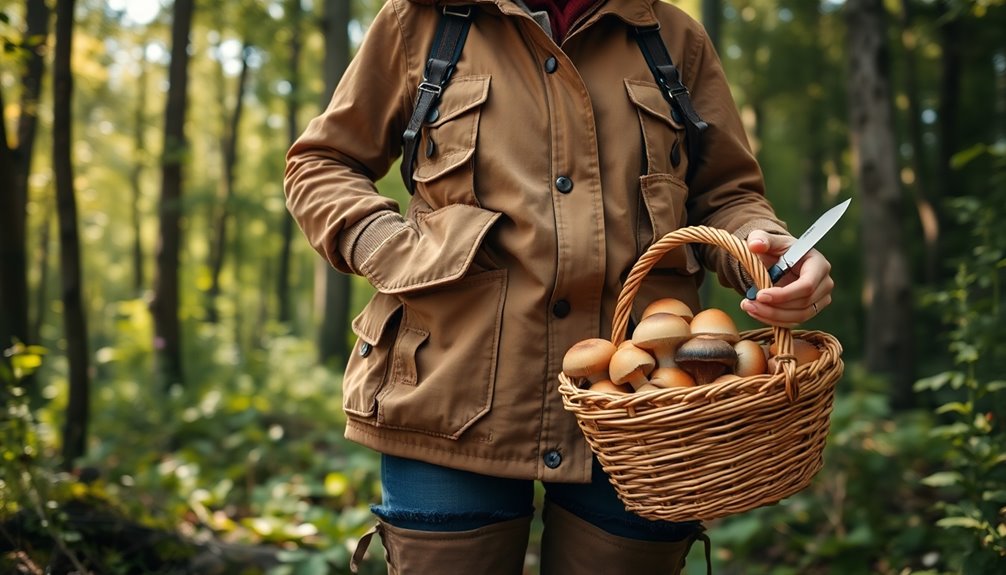
For mushroom picking, having the right tools can greatly enhance your foraging experience. A sturdy mushroom basket is essential; its sections allow you to separate different types of mushrooms, preventing cross-contamination. This organization is vital, especially when you're excited about your finds during foraging trips.
You'll also want to invest in a special knife designed for mushroom picking. These knives typically feature a brush on one end, making it easier to clean dirt off mushrooms without damaging them. This is especially handy when you're dealing with delicate varieties.
An extra bag is a smart addition for unplanned excursions, serving as a substitute if your basket fills up. Consider portable storage containers with compartments, too. They help you keep various mushroom types organized, which is vital for cooking later.
Finally, keeping a backup bucket in your car can be a lifesaver. It's perfect for transporting larger quantities of mushrooms or for emergency situations when you need additional storage.
With these tools, you'll be well-equipped to make the most of your mushroom picking adventures!
Safety Precautions
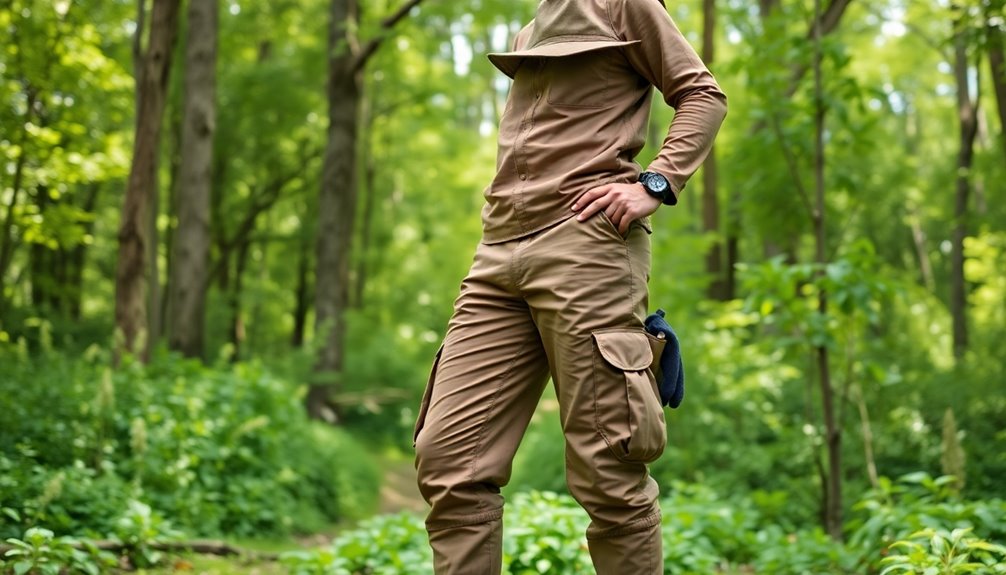
Venturing into the wilderness for mushroom foraging can be exhilarating, but safety should always be your top priority. Make certain to inform a friend or family member about your foraging plans and your expected return time. This simple step guarantees someone knows your whereabouts in case of an emergency.
Stay aware of your surroundings and familiarize yourself with the area to avoid getting lost, especially in dense forests where landmarks can often be hard to identify. Regularly check weather conditions before and during your trip, and carry a waterproof jacket to prepare for sudden changes in weather, which can be unpredictable.
You'll want to bring enough water and snacks to keep you cool and maintain your energy levels, as foraging can be physically demanding.
It's vital to recognize your physical limits and take breaks when necessary. Overexertion can lead to fatigue, which often times results in accidents and injuries.
Enhancing the Foraging Experience

After ensuring your safety and preparing for the wilderness, think about how to enhance your foraging experience. Foraging with friends can make the adventure not only safer but also more enjoyable. Sharing knowledge about wild berries and edible plants enriches your time outdoors. Plus, connecting with nature fosters mindfulness and self-reliance, deepening your appreciation for the environment. In regions like Minnesota, you can find an abundance of wild edibles that enrich the foraging experience, including historical significance of foraging baskets used by various cultures. Additionally, understanding local climate patterns can significantly aid in identifying the best times for foraging. Furthermore, being aware of mushroom foraging regulations in your area can help ensure a responsible foraging practice.
To maximize your foraging success, research local areas and popular spots. Familiarizing yourself with what grows in your region helps you locate edible plants efficiently. Here's a quick guide to keep in mind:
| Activity | Benefits | Tips |
|---|---|---|
| Foraging with friends | Safety and shared knowledge | Plan a group trip |
| Mindfulness | Greater appreciation for nature | Focus on the experience |
| Research | Increased chances of success | Use foraging apps or books |
| Learning about edibility | Prevent health risks | Always confirm before consuming |
Moreover, being equipped with essential tools like foraging baskets can improve your efficiency in gathering wild edibles.
Frequently Asked Questions
What Clothes Are Best for Foraging?
When you're heading out foraging, you'll want to wear breathable fabrics like cotton or linen to keep cool.
Layer your clothing with a moisture-wicking base, a lightweight insulation layer, and a waterproof outer layer for weather changes.
Long trousers and long-sleeved shirts protect you from scratches and bugs.
Don't forget sturdy, closed-toe footwear for grip and support, and use sun protection like hats and sunscreen to shield against UV rays.
What to Wear in the Wilderness?
When you're heading into the wilderness, you need to wear breathable fabrics like cotton or linen to keep cool.
Layer your clothing with moisture-wicking materials and a waterproof outer layer for unpredictable weather.
Opt for durable, long-sleeved shirts and pants to protect yourself from scratches and bites.
Don't forget sturdy, closed-toe footwear with good ankle support and grip, along with sun protection like hats and sunscreen to shield against UV rays.
How to Dress for Mushroom Foraging?
Imagine you're stepping into a vibrant, enchanted forest, ready to discover hidden treasures.
When dressing for mushroom foraging, you'll want long trousers and a long-sleeved shirt to shield against scratches and bites. Choose moisture-wicking layers to stay comfortable, and sturdy hiking boots for support on uneven ground.
Don't forget a wide-brimmed hat for sun protection and bright colors for visibility.
Gear up, and you'll be ready to forage safely and stylishly!
How Did Hunter Gatherers Dress?
Hunter-gatherers dressed in garments made from animal skins, furs, and plant fibers, which kept them warm and protected from the elements.
They tailored their clothing for mobility, ensuring you could move easily during hunting or gathering.
You'd notice natural dyes creating colors for camouflage in your surroundings.
Accessories like belts and pouches were crafted to hold tools and foraged goods, while seasonal changes influenced your choice of layers for comfort and protection.
Conclusion
As you step into the wild, clad in rugged boots and breathable layers, you're not just a forager—you're an adventurer, channeling your inner Thoreau. With your trusty basket and tools at hand, every leaf rustle becomes a whisper of nature's secrets. Embrace the thrill of discovery, knowing you're equipped to savor nature's bounty safely. So go ahead, let the forest be your guide and the harvest your reward, as you weave through the greenery like a seasoned pro.

